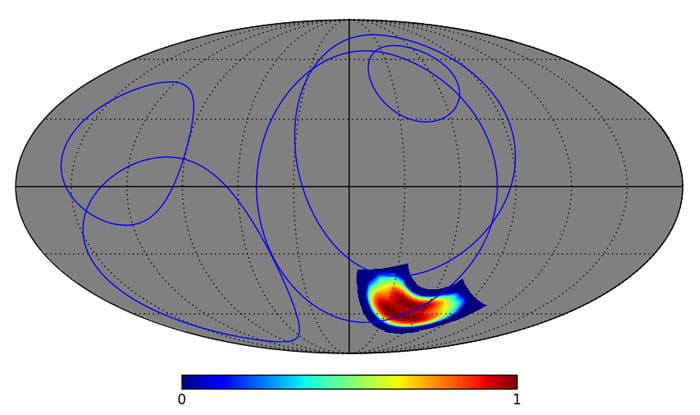
“Radio loop” emissions, rather than signatures of the early universe, could account for the observation of B-mode polarization announced by the BICEP2 collaboration earlier this year. That is the claim of a trio of cosmologists that has found evidence that local structures in our galaxy generate a polarized signal that was previously unknown to astronomers studying the cosmic microwave background (CMB). The new foreground, which can be detected in the radio and microwave frequencies, is present at high galactic latitudes and could potentially be misinterpreted as a B-mode polarization signal caused by primordial gravitational waves, thus casting doubt on the BICEP2 finding.
There are two important sources of electromagnetic emissions in our galaxy that researchers need to account for while carrying out large-scale surveys of the CMB. They are synchrotron radiation from electrons moving in the galactic magnetic field and polarized emission from dust, with the latter being particularly poorly understood. Surveys of our galaxy carried out as early as 1971 also found evidence of “radio loops” or diffuse radio emission, which stood out against the galactic radio background. These loops are now thought to be caused by ancient supernova remnants that have grown to colossal sizes of 100 to 300 parsecs, after continually expanding for tens to hundreds of thousands of years. These expanding shells of gas and dust were accelerated by the supernova’s shock waves or by stellar winds.
Supernova shells
Subir Sarkar of the Particle Theory Group at the University of Oxford and the Niels Bohr Institute in Copenhagen, who has been studying these radio loops since the 1980s, wondered whether the supernova shells also trapped dust, in which case they might constitute an important foreground in experiments studying the CMB. Sarkar, along with Philipp Mertsch at Stanford University in the US and Hao Liu, also from the Niels Bohr Institute, used data from NASA’s Wilkinson Microwave Anisotropy Probe (WMAP) and found that the radio-loop foreground has indeed evaded the usual “cleaning” methods employed by both the WMAP and Planck experiments.
It is fairly well known that the radio loops produce some sort of synchrotron emission, thanks to charged particles from cosmic rays gyrating inside the magnetic field of the shells. What is new is the suggestion that dust grains, which are enriched with metallic iron or ferrimagnetic molecules, might produce shorter-wavelength radiation that is polarized because of the alignment of the grains with the galactic magnetic field. Surprisingly, Sarkar and colleagues found evidence for this radiation not only at radio frequencies, but also at microwave frequencies. This might result in a significant contamination of the B-mode signal apparently detected by BICEP2, especially as the region of the sky studied by the telescope is crossed by one of these loops.
Sarkar says that if the BICEP2 experiment has seen B-mode polarization, “they do not know if this is cosmological in origin, with momentous implications for gravitational waves from inflation or just foreground”. The BICEP2 researchers discount the latter option by cross-correlating what they see with the best available models of the galactic foreground. “However, these models do not include the new source of foreground we have identified. [BICEP2] have not made their sky maps public so we cannot check if what they have seen correlates with these foreground structures – one of which crosses the very region of the sky they looked at,” says Sarkar. It remains to be seen whether Sarkar’s findings will nullify BICEP2’s claim of having seen primordial gravitational waves, or if the foreground ultimately does not affect the finding.
More frequencies needed
“My greatest worry about the BICEP2 results is that the measurement is made at a single frequency, 150 GHz. In order to be convinced that the signal is cosmological, rather than arising from a foreground source, I would need to see it confirmed by other measurements at different frequencies,” says Peter Coles, a physicist at the University of Sussex who was not involved in the new work. He explains that a truly cosmological signal would look the same irrespective of frequency, while a foreground emission would be frequency-dependent. “The question should be asked whether the radiation pattern in the part of the sky observed by BICEP2 correlates with measurements at different frequencies, such as those observed by Planck. If the answer to this is ‘yes’, then that is more evidence that BICEP2 may have measured polarized emission from galactic dust rather than from the Big Bang.”
David Spergel of Princeton University in the US, who was also not involved with Sarkar’s research, says that the radio-loop emission is weak enough to not be a “significant contaminant” in the WMAP and Planck temperature maps. “However, since the polarization signal is less than 100th of the temperature signal, these subtle effects are much more important for analysis of the polarization data,” he says.
Essential cross-checks
While Sarkar’s recent paper on the work only considers WMAP data, he told physicsworld.com that the same structures are also seen in the public Planck maps. “In my view, the community has been rather uncritical in accepting [BICEP2’s] claim without waiting for the essential cross-checks, such as whether the same signal is seen at several different frequencies, and independent confirmation by Planck,” says Sarkar.
Fortunately, Sarkar, Coles and Spergel all agree that all eyes are now on the upcoming polarization data from the Planck satellite, which should clarify the situation within the year. “Planck has polarization measurements across the whole sky at multiple frequencies, so it will provide both a detailed characterization of galactic emission and should hopefully also confirm the BICEP2 results and show convincingly that the emission is cosmological,” says Spergel.
The research is described in a preprint on the arXiv server.
Update: The paper has been published in the Astrophysical Journal – Letters.




